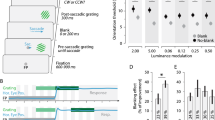Abstract
Study of the visual Illusion known as the Pulfrich phenomenon with random dot stereo movies confirms that the filtering of one eye in effect introduces a delay in the system for that eye, which is the probable cause of the illusion. Other features of the illusion suggest that the considerable inertia in the stereoscopic depth process leads to the averaging of several successive frames in each eye.
This is a preview of subscription content, access via your institution
Access options
Subscribe to this journal
Receive 51 print issues and online access
$199.00 per year
only $3.90 per issue
Buy this article
- Purchase on SpringerLink
- Instant access to full article PDF
Prices may be subject to local taxes which are calculated during checkout
Similar content being viewed by others
References
Pulfrich, C., Naturwissenschaften, Berl., 10, 553, 569, 596, 714, 735 (1922).
Lit, A., Amer. J. Psychol., 62, 159 (1949).
Harker, G. S., Perception and Psychophysics, 2, 423 (1967).
Julesz, B., Science, 145, 356 (1964).
Julesz, B., and Payne, R. A., Vision Res., 8, 433 (1968).
Author information
Authors and Affiliations
Rights and permissions
About this article
Cite this article
JULESZ, B., WHITE, B. Short Term Visual Memory and the Pulfrich Phenomenon. Nature 222, 639–641 (1969). https://doi.org/10.1038/222639a0
Received:
Issue date:
DOI: https://doi.org/10.1038/222639a0
This article is cited by
-
Interocular contrast difference drives illusory 3D percept
Scientific Reports (2017)
-
Temporal integration limits of stereovision in reaching and grasping
Experimental Brain Research (2008)
-
Decision-making in second-eye cataract surgery: can presence of Pulfrich phenomenon help?
Eye (2007)
-
Influence of the Pulfrich phenomenon on driving performance
Graefe's Archive for Clinical and Experimental Ophthalmology (2006)
-
Joint-encoding of motion and depth by visual cortical neurons: neural basis of the Pulfrich effect
Nature Neuroscience (2001)



